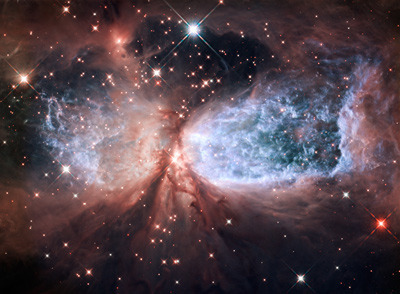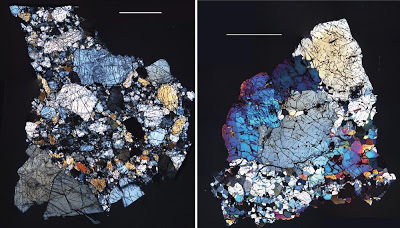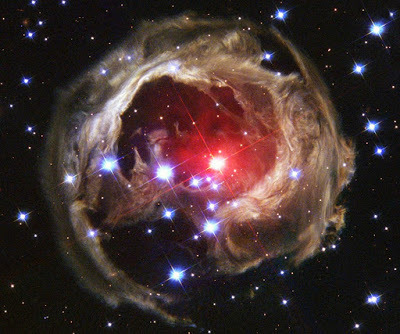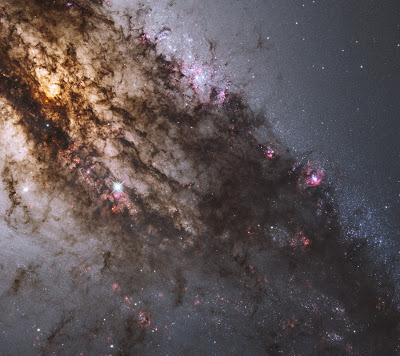Eleanor Arnason's Blog, page 63
December 17, 2011
From the Hubble Site

ABOUT THIS IMAGE:
NASA's Hubble Space Telescope presents a festive holiday greeting that's out of this world. The bipolar star-forming region, called Sharpless 2-106, looks like a soaring, celestial snow angel. The outstretched "wings" of the nebula record the contrasting imprint of heat and motion against the backdrop of a colder medium.
Sharpless 2-106, Sh2-106 or S106 for short, lies nearly 2,000 light-years from us. The nebula measures several light-years in length. It appears in a relatively isolated region of the Milky Way galaxy.
A massive, young star, IRS 4 (Infrared Source 4), is responsible for the furious activity we see in the nebula. Twin lobes of super-hot gas, glowing blue in this image, stretch outward from the central star. This hot gas creates the "wings" of our angel.
A ring of dust and gas orbiting the star acts like a belt, cinching the expanding nebula into an "hourglass" shape. Hubble's sharp resolution reveals ripples and ridges in the gas as it interacts with the cooler interstellar medium.
Dusky red veins surround the blue emission from the nebula. The faint light emanating from the central star reflects off of tiny dust particles. This illuminates the environment around the star, showing darker filaments of dust winding beneath the blue lobes.
Detailed studies of the nebula have also uncovered several hundred brown dwarfs. At purely infrared wavelengths, more than 600 of these sub-stellar objects appear. These "failed" stars weigh less than a tenth of our Sun. Because of their low mass, they cannot produce sustained energy through nuclear fusion like our Sun does. They encompass the nebula in a small cluster.
The Hubble images were taken in February 2011 with the Wide Field Camera 3. Visible narrow-band filters that isolate the hydrogen gas were combined with near-infrared filters that show structure in the cooler gas and dust.
Published on December 17, 2011 11:02
December 10, 2011
Deadlines
I've been thinking about deadlines, because Timmi Duchamp gave me a one weekend deadline for a brief essay for the Aqueduct blog. I made it.
I don't like deadlines. For the most part, I write what I want at the speed I want and don't try selling fiction before it's done. When I have had deadlines for fiction, I have usually not made them.
The writing group I'm in -- the Wyrdsmiths -- has a majority of writers who do work to deadline; and I am rethinking my attitude. Sometimes I have genuine creative reasons for writing slowly and taking time off. I need to mull ideas or figure out how to reorganize a story, because it's not heading in a direction I like. But I also suffer from perfectionism and procrastination. I will avoid writing and stall on completing stories for fear the work is not any good.
I'm not as young as I once was. As Andrew Marvell wrote, "...At my back I always hear Time's winged chariot hurrying near: and younder all before us lie deserts of vast eternity." That being so, I'd like to write more rapidly, and this leads me to consider the merits of deadlines.
Since I am writing short stories these day, I am not going to have many deadline set by editors, unless I move into the theme anthology market. But I can set my own deadlines and be serious about meeting them. Or I can simply get serious about writing every day, making production...
I don't like deadlines. For the most part, I write what I want at the speed I want and don't try selling fiction before it's done. When I have had deadlines for fiction, I have usually not made them.
The writing group I'm in -- the Wyrdsmiths -- has a majority of writers who do work to deadline; and I am rethinking my attitude. Sometimes I have genuine creative reasons for writing slowly and taking time off. I need to mull ideas or figure out how to reorganize a story, because it's not heading in a direction I like. But I also suffer from perfectionism and procrastination. I will avoid writing and stall on completing stories for fear the work is not any good.
I'm not as young as I once was. As Andrew Marvell wrote, "...At my back I always hear Time's winged chariot hurrying near: and younder all before us lie deserts of vast eternity." That being so, I'd like to write more rapidly, and this leads me to consider the merits of deadlines.
Since I am writing short stories these day, I am not going to have many deadline set by editors, unless I move into the theme anthology market. But I can set my own deadlines and be serious about meeting them. Or I can simply get serious about writing every day, making production...
Published on December 10, 2011 09:36
Spontaneity and Honesty
I have been reading Natalie Goldberg's book Writing Down the Bones. Goldberg is very much self-identified as a writer. Most of her work has about the process of writing. She is a writer who writes about how to write. She has also published poetry, which I don't find especially interesting, and a novel I didn't like. Her best work is either memoir or how-to writing books or a combination.
She studied Zen with Katagiri Roshi in Minneapolis, and what she describes is very much writing as a Zen practice. In fact, Katagiri told her writing was her practice.
She emphasizes spontaneity and honesty, writing that comes straight from the heart. I enjoy reading her and think about using her writing exercises. But in my own writing I value control and lying. My writing, especially my prose fiction, is not spontaneous; it's worked over, revised and refined. Most of my writing is fiction and untrue. In fact, it is is not even realistic. It is science fiction and fantasy. I keep thinking about the line from Hamlet: "By indirections find directions out." Using fiction, one finds or says the truth.
I draw on my own life, my experiences and feelings, but I don't show them directly. They are hidden in the tale. And my stories wander into unplanned places. In that sense, they are spontaneous. But control is always present. I am not going to become enlightened working this way. But I am reasonably happy with the stories.
She studied Zen with Katagiri Roshi in Minneapolis, and what she describes is very much writing as a Zen practice. In fact, Katagiri told her writing was her practice.
She emphasizes spontaneity and honesty, writing that comes straight from the heart. I enjoy reading her and think about using her writing exercises. But in my own writing I value control and lying. My writing, especially my prose fiction, is not spontaneous; it's worked over, revised and refined. Most of my writing is fiction and untrue. In fact, it is is not even realistic. It is science fiction and fantasy. I keep thinking about the line from Hamlet: "By indirections find directions out." Using fiction, one finds or says the truth.
I draw on my own life, my experiences and feelings, but I don't show them directly. They are hidden in the tale. And my stories wander into unplanned places. In that sense, they are spontaneous. But control is always present. I am not going to become enlightened working this way. But I am reasonably happy with the stories.
Published on December 10, 2011 07:30
NASA APOD

These colorful images are of thin slices of meteorites viewed through a polarizing microscope. Part of the group classified as HED meteorites for their mineral content (Howardite, Eucrite, Diogenite), they likely fell to Earth from 4 Vesta, the mainbelt asteroid currently being explored by NASA's Dawn spacecraft. Why are they thought to be from Vesta? Because the HED meteorites have visible and infrared spectra that match the spectrum of that small world. The hypothesis of their origin on Vesta is also consistent with data from Dawn's ongoing observations. Excavated by impacts, the diogenites shown here would have originated deep within the crust of Vesta. Similar rocks are also found in the lower crust of planet Earth. A sample scale is indicated by the white bars, each 2 millimeters long.
Published on December 10, 2011 07:27
December 4, 2011
NASA APOD

For reasons unknown, star V838 Mon's outer surface suddenly greatly expanded with the result that it became the brightest star in the entire Milky Way Galaxy in January 2002. Then, just as suddenly, it faded. A stellar flash like this has never been seen before. It's true that supernovae and novae expel matter out into space. But while the V838 Mon flash appears to expel material into space, what is seen here is actually an outwardly moving light echo of the bright flash. In a light echo, light from the flash is reflected by successively more distant rings in the ambient interstellar dust that already surrounded the star. V838 Mon lies about 20,000 light years away toward the constellation of Monoceros the unicorn. In this Hubble Space Telescope image from February 2004, the light echo is about six light years in diameter.
Published on December 04, 2011 05:54
November 30, 2011
Curiosity on Route to Mars

Next stop: Mars. This past weekend the Mars Science Laboratory carrying the Curiosity Rover blasted off for the red planet atop an Atlas V rocket from Cape Canaveral, Florida, USA, as pictured above. At five times the size of the Opportunity rover currently operating on Mars, Curiosity is like a strange little car with six small wheels, a head-like camera mast, a rock crusher, a long robotic arm, and a plutonium power source. Curiosity is scheduled to land on Mars next August and start a two year mission to explore Gale crater, to help determine whether Mars could ever have supported life, and to help determine how humans might one day visit Earth's planetary neighbor.
Published on November 30, 2011 05:13
November 29, 2011
NASA APOD

A fantastic jumble of young blue star clusters, gigantic glowing gas clouds, and imposing dark dust lanes surrounds the central region of the active galaxy Centaurus A. This image from the Hubble Space Telescope has been processed to present a natural color picture of this cosmic maelstrom. Infrared images from the Hubble have also shown that hidden at the center of this activity are what seem to be disks of matter spiraling into a black hole with a billion times the mass of the Sun. Centaurus A itself is apparently the result of a collision of two galaxies and the left over debris is steadily being consumed by the black hole. Astronomers believe that such black hole central engines generate the radio, X-ray, and gamma-ray energy radiated by Centaurus A and other active galaxies. But for an active galaxy Centaurus A is close, a mere 10 million light-years away, and is a relatively convenient laboratory for exploring these powerful sources of energy.
Published on November 29, 2011 08:41
November 25, 2011
Gratitude Post
The sunrise today was good. Right now I am sitting in our living room and listening to MPR, which is no longer doing Thanksgiving programming, for which I am thankful. Soon I will go to exercise. I am beginning to almost like exercise... Not working for The Man or The Woman is a pleasure. I have some minor tasks today, then reading or writing or a walk along the river. It's a good river, not the Mighty MIssissippi farther south, after the Missouri and the Ohio come in, but a fairly wide flow of clear, brown water. I think the brownness comes from tannin in the bogs up north.
Patrick has a large teddy bear, which was given to him by a homeless man years ago.
Patrick said to the man, "This is very nice, but don't you want to keep the bear?"
The man said, "Nah. I have one."
The bear sits in our Mission style rocking chair, filling the entire chair, and he reminds us of what is important: we have a home and family and friends. Three more things to be grateful for.
Patrick has a large teddy bear, which was given to him by a homeless man years ago.
Patrick said to the man, "This is very nice, but don't you want to keep the bear?"
The man said, "Nah. I have one."
The bear sits in our Mission style rocking chair, filling the entire chair, and he reminds us of what is important: we have a home and family and friends. Three more things to be grateful for.
Published on November 25, 2011 07:19
Gradtitude Post
The sunrise today was good. Right now I am sitting in our living room and listening to MPR, which is no longer doing Thanksgiving programming, for which I am thankful. Soon I will go to exercise. I am beginning to almost like exercise... Not working for The Man or The Woman is a pleasure. I have some minor tasks today, then reading or writing or a walk along the river. It's a good river, not the Mighty MIssissippi farther south, after the Missouri and the Ohio come in, but a fairly wide flow of clear, brown water. I think the brownness comes from tannin in the bogs up north.
Patrick has a large teddy bear, which was given to him by a homeless man years ago.
Patrick said to the man, "This is very nice, but don't you want to keep the bear?"
The man said, "Nah. I have one."
The bear sits in our Mission style rocking chair, filling the entire chair, and he reminds of what is important: we have a home and family and friends. Three more things to be grateful for.
Patrick has a large teddy bear, which was given to him by a homeless man years ago.
Patrick said to the man, "This is very nice, but don't you want to keep the bear?"
The man said, "Nah. I have one."
The bear sits in our Mission style rocking chair, filling the entire chair, and he reminds of what is important: we have a home and family and friends. Three more things to be grateful for.
Published on November 25, 2011 07:19
Present and Future
I just wrote the following on facebook:
After I wrote I realized this was an actual insight. To-do lists keep me focused on the future, and I do live by to-do lists. I wonder what I can do with the insight. Maybe keep another list -- a gratitude list -- of what's happening in the present.
I would hate to give up all lists.
A second insight might be: my love of science fiction also keeps me thinking about the future.
A third insight might be: it's not entirely bad to think about the future. That's where the consequences of our current actions will happen.
There must be a way to balance present and future.
Gratitude practice is something Buddhists do. I'm working on setting up a practice with a Buddhist friend. I live by to-do lists, which is a way of focusing on the future and forgetting about the present. Better to live in the present and say, "Ah, yes!"
After I wrote I realized this was an actual insight. To-do lists keep me focused on the future, and I do live by to-do lists. I wonder what I can do with the insight. Maybe keep another list -- a gratitude list -- of what's happening in the present.
I would hate to give up all lists.
A second insight might be: my love of science fiction also keeps me thinking about the future.
A third insight might be: it's not entirely bad to think about the future. That's where the consequences of our current actions will happen.
There must be a way to balance present and future.
Published on November 25, 2011 06:38
Eleanor Arnason's Blog
- Eleanor Arnason's profile
- 73 followers
Eleanor Arnason isn't a Goodreads Author
(yet),
but they
do have a blog,
so here are some recent posts imported from
their feed.



